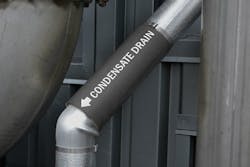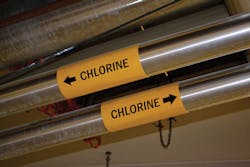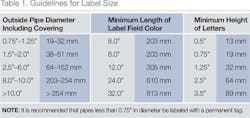Benefits of Pipe Marking for Water Treatment Facilities
By Joel Bradbury
Two major pipe marking standards have been developed by representatives from 10 U.S. states and one Canadian province. They are: Recommended Standards for Wastewater Facilities and Recommended Standards for Water Works.
These standards are part of a set of standards called the 10 States Standards. Over time other states have either adopted these standards or used them as a baseline for their own standards. Each standard provides guidelines on how pipes should be marked to improve safety and efficiency.
Basic Pipe Marker Elements
In general, there are five elements that make an effective pipe label. These elements are:
- Color coding: Provides a means for workers to quickly identify the general pipe contents and potential hazards.
- Text: Identifies the pipe’s exact contents and may also display other hazards like temperature or pressure.
- Arrows: Indicate the direction of flow, including when contents may flow in either direction.
- Label placement: Ensures people will see the label and be able to access the information they need with minimum effort.
- Size: Choosing the right size label and text ensures pipe markers can be read.
The first four elements are covered in the 10 State Standards, and guidelines for the fifth can be found in another standard: ASME A13.1 (2015), which is maintained by the American Society of Mechanical Engineers.
Wastewater Facilities
There are some important nuances in the 2014 Edition of the Recommended Standards for Wastewater Facilities. Like most pipe marking standards, this standard provides some guidance on label placement, stating that pipes must be labeled every 10 feet (3 meters). However, there is a unique requirement not found in other standards: At least two labels must be in every room, closet, and piping case.
The next area of note revolves around color coding. The standard provides a recommended color scheme that assigns different colors for various types of sludge, gas, water, chemicals, and other things like plumbing drains and vents. While color coding aids workers in the identification of a pipe’s contents, it is not sufficient on its own. This may be, in part, because some colors are used for more than one content type. Red, for example, is used to identify fuel oil/diesel, natural gas, sludge gas, and fire mains. Here there is an obvious conflict: Both contents that can make a fire worse and those that can quench a fire may be identified with the same color. Using text to clearly identify each pipe’s contents is essential for safety.
When marking pipes, it’s important to do it correctly, yet there is some contradiction about exactly how pipes should be marked. This is the final nuance. Section 54.5 states that “the contents and direction of flow shall be stenciled on the piping in a contrasting color.” Meanwhile, Section 57.25 states: “All piping containing or transporting corrosive or hazardous chemicals shall be identified with labels.” So what should be done? With the advancement in label durability and longevity of materials, many authorities will accept labels in place of stenciled markings.
Water Works Facilities
The 2012 edition of the Recommended Standards for Water Works also provides guidance for pipe marking. While this standard suggests including the name of the chemical or liquid as well as the direction of flow on labels, it does not provide any guidance for how often a pipe should be labeled. It does, however, include a comprehensive color code and specific requirements for feed equipment.
First, this standard separates color codes into three categories: water lines, chemical lines, and other. When colors are too similar to easily differentiate, the standard suggests using a six-inch band every 30 inches to help workers identify each pipe’s contents.
For bulk storage of liquid chemicals, day tank entry points must be labeled with the name of the chemical they contain. In addition, the standard recommends labeling and color coding feed lines to improve recognition.
Learn more about the 10 States Standards and the suggested color codes with the Water Treatment Pipe Marking Guide by Graphic Products.
Additional Guidance
While both of these standards provide some excellent guidelines for marking pipes in water treatment facilities, there is some room for improvement as neither provides any guidelines for label size. Help with this element can be found in ASME A13.1 (see Table 1). Following these guidelines will ensure that your facility’s pipe markers will be seen when needed.
Safety
As with any workplace, effective communication is an essential part of day-to-day operations for sharing vital information and helping workers stay safe. To this end, pipe marking forms a critical part of your workplace communication program by:
- Providing information in an easy-to-read and consistent manner.
- Using color coding to support quick identification of contents.
- Complementing your chemical hazard communication program (HazCom 2012).
Supported by a comprehensive color scheme, workers will more easily identify the contents of pipes and hazards they may contain, helping them prepare for work. In a wastewater treatment facility, for example, workers immediately know that a dark green pipe contains pressurized air. In response, workers are informed of the hazard pressurized air presents and can bleed and isolate pipes before performing maintenance. When moving from one facility to another, workers will continue to be able to identify the contents of pipes without having to learn a new pipe marking system.
An added benefit of using a standardized pipe marking scheme is that it helps you meet HazCom 2012’s requirement for communicating hazards in the workplace. Using a relevant standard, like the 10 States Standards, you can be assured that your facility will effectively communicate the hazards related to the contents of its pipes.
Efficiency
To keep water treatment facilities operating in peak condition, workers have to perform regular maintenance. To aid workers in their tasks, properly marked pipes improve efficiency, enabling workers to move from task to task without needing to reference binders or charts. This reduces the time spent reviewing schematics because much of the needed information is located directly on the pipes. In addition, having information located at the point of use reduces errors and mistakes caused by not knowing what’s in each pipe.
About the Author: Joel Bradbury is a native Washingtonian with a Masters Degree in Rhetoric and Technical Communications. At Graphic Products in Beaverton, Ore., Joel specializes in writing detailed resources, such as articles and best practice guides on Lean, 5S, Kaizen, OSHA compliance, and organizational safety topics. Graphic Products offers a line of printers and supplies to support visual communication objectives. Learn more at www.graphicproducts.com. Circle No. 232 on Reader Service Card



